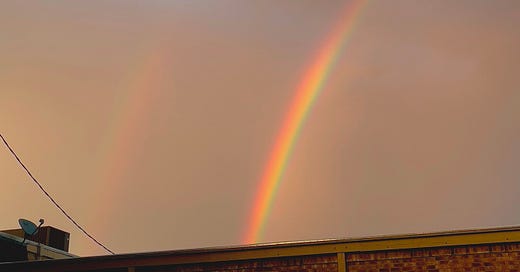Storytelling, the hand that pulls us from the pit
When you’ve been stuck for a long time, movement itself is a miracle
Rather than explaining every element of my art, I want to invite people into it. To feel it, to sit with it, to sense what’s being said without me spelling it out. I believe in the kind of storytelling that trusts the audience. When art is made thoughtfully, it doesn’t have to shout. It resonates. It reveals.
Humans are inseparable from stories. We live inside them. We define ourselves through them. From the time we’re children, we understand the world through characters, arcs, tension, and meaning. Even as adults, it’s not the facts that stick — it’s the story that wrapped around them. The line in a film that pierced us. The song that made us ache. The poem that somehow said what we couldn’t. Even if we don’t fully understand why, we remember what made us feel.
Stories teach without preaching. (Says the pastor’s kid.) They give us something to hold onto in the dark. They let us name what hurts. They let us carry questions without rushing to answers. The best stories don’t tell us what to think — they show us something true, and invite us to discover what it means.
I’ve come to believe that’s also what stories do in our personal lives. They help us make sense of the mess. When I’m in the thick of something painful, it feels endless and senseless … like I’m buried. But over time, I’ve started to see that I’m not buried … I’m in a story. And stories move. They shift. They unfold. They don’t leave us where they found us.
Right now, I’m emerging from one of those dark middles. A chapter that feels painfully familiar. I’ve lived this storyline before. In high school. In college. In church communities I once considered home. Again and again, I found friendships that felt safe, only to have them unravel through misunderstanding. People I trusted turning cold. Half-truths becoming full-blown stories that erased my side entirely.
It’s a particular kind of heartbreak when the ones you let in the deepest are the ones who wound you. When what once felt like sanctuary becomes a battlefield. The pain isn’t just about what happened — it’s about what it undoes. The stability. The sense of belonging. The quiet belief that maybe this time you’ve found your people.
And underneath it all has always been this ache for family. For chosen, rooted, unshakable connection. That’s why gossip hurts so much. Not just because it distorts who I am, but because it threatens what I’ve been hoping for most: to be known and still loved.
But something’s shifting now. For the first time, I’m not just reacting to the pain. I’m starting to recognize the pattern. I can see the story I’m in.
And strangely, that changes everything.
The naming of it, the noticing, becomes a kind of key. A way out of the pit. A way forward. Maybe not all at once. Maybe not cleanly. But there’s movement. And when you’ve been stuck for a long time, movement itself is a miracle.
That’s the power of story.
It helps us unstick what feels frozen. It gives shape to things too heavy to hold. And sometimes, just knowing you’re in a story is what helps you survive it.
That’s also the kind of art I try to create. Not something perfectly explained. But something that breathes. That holds tension. That lets people feel something they didn’t have language for. Something that maybe helps them find a key, too.
Storytelling has a rhythm. A structure. But the most powerful stories know when to break the rules. When to pause in silence. When to linger in mystery. When to leave something unsaid. Often, the most sacred parts are the ones that don’t resolve neatly.
A chord progression that says what words can’t. A visual that feels like déjà vu. A crack in the voice that tells the real story. These don’t need to be explained. They just need to be felt.
When I create, I’m not offering a manual. I’m opening a door. Because the best art doesn’t force you into its meaning. It offers a key to your own.





